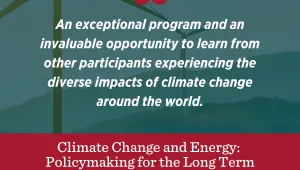The full discussion paper is available for download here: http://belfercenter.ksg.harvard.edu/publication/18735/
OVERVIEW
Managing the dangers of global climate change will require developing countries to participate in a global climate regime. So far, however, those nations have been nearly universal in their refusal to make commitments to reduce growth in their greenhouse gas emissions. This paper describes how a set of international "Climate Accession Deals" could encourage large policy shifts that are in developing countries' interests and also reduce greenhouse gas emissions.
DISCUSSION
Conventional "carrot and stick" strategies for engaging developing countries are unlikely to be effective. The biggest carrot — the Kyoto Protocol's Clean Development Mechanism (CDM) — requires difficult judgments about whether emissions reductions are additional, is plagued by high transaction costs, and creates perverse incentives for developing countries to avoid policies that would reduce emissions. Threats of climate-related trade sanctions could, in theory, encourage developing countries to do more. But such tools are blunted by their questionable legal basis, high administrative costs, and adverse impacts on the world trading system. Although these approaches could be fine-tuned, a fundamentally different approach will be needed.
This paper suggests a new strategy for engaging developing countries, focusing on the concept of Climate Accession Deals (CADs). These deals would take advantage of the fact that there are many large policy shifts that are in these countries' interests and which also, fortuitously, reduce greenhouse gases. Each CAD would include a set of policies that are tailored to gain maximum leverage on a single developing country's emissions, while also aligning with its interests and capabilities so that the initial investments are easily expanded with few incentives for developing countries to abandon the effort once under way. Industrialized countries would support each CAD by providing specific benefits such as financial resources, technology, administrative training, or security guarantees.
The closest analogy to CADs is the accession process to the World Trade Organization (WTO). As with WTO accession agreements, CADs would be complex to engineering (thus must be few in number and must initially focus on the countries with the highest potential for reducing emissions) and would not be an end point to engagement with developing countries. Rather, they would frame a long term transition during which the developing country would become a full member of the climate regime — eventually setting targets that span the entire economy and adopting complementary policies.
KEY FINDINGS & RECOMMENDATIONS
- Compared to conventional approaches, Climate Accession Deals have several important advantages. First, they are anchored in host countries' interests and capabilities and thus do not require negotiating agreements that run contrary to a country's interests. Second, they are limited in number and can be crafted through a bidding process that would allow maximum leverage while minimizing external investment. Third, all involve a complex array of interests and institutions, and thus would engage more than the environmental and foreign affairs ministries that have dominated climate diplomacy to date. Fourth, all CADs are replicable and scalable. Where they succeed, they offer paths for similar deals (at lower cost) in other countries and are self-reinforcing in the original host country.
Examples of potential Climate Accession Deals include:
- A CAD for China should focus on carbon emissions from coal, which accounts for 69% of its primary energy system. Recent energy shortages and higher energy prices have caused Chinese officials to initiate programs to decouple economic growth from energy consumption. A CAD could encourage this goal by making new power plants more efficient, encouraging greater use of natural gas and nuclear fuel, improving the efficiency of the electric power grid, and funding research projects on new systems for electric supply. Improved efficiency of the power supply system could save more than 200 million tons of CO2 annually.
- A CAD for India should also seek ways to use coal more efficiently and supplant coal. The greatest opportunity for leverage on India's emissions lies in boosting the efficiency of converting coal to electricity. Other energy sources, include hydro, wind, gas, and nuclear power, could also make a difference at the margin. Improving the country's weak system for power delivery would reduce greenhouse gas emissions, as would expanding access to electricity to reduce particulate emissions from traditional biomass usage.
- In South Africa, a CAD supporting deployment of advanced power plants might save 50–100 million tons of CO2 annually by 2025. A carbon storage scheme might increase that amount another 20 million tons.
- CADs for Brazil and Indonesia should focus on preventing and reversing deforestation. One area of assistance could be the provision of surveillance radar, drones, and helicopters for a much larger police force. Such systems would allow these countries to better use existing personnel to monitor deforestation and regulate illegal logging.
- A CAD for Russia should target flaring of natural gas. Flaring at Russian oil operations releases the equivalent of 175 million tons of CO2 annually.
CONCLUSION
A serious strategy for engaging developing countries in a global climate agreement must contend with two truths. First, at present, developing nations value economic growth far more than future global environmental conditions. Second, many governments of developing nations have little administrative ability to control emissions. Climate Accession Deals could address both of these barriers to effective engagement of developing countries in a way that is consistent with their incentives and also effective in putting them on a path to fuller commitments to reduce emissions.
Victor, David G.. “Climate Accession Deals: New Strategies for Taming Growth of Greenhouse Gases in Developing Countries—Summary.” Harvard Project on Climate Agreements, Belfer Center, December 2008



